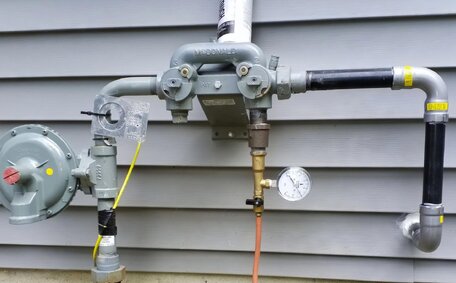The Role of Natural Gas in a Sustainable Energy Future
Natural gas is critical in today’s energy landscape; however, the future lies in innovative, unconventional gas sources such as biomethane and green hydrogen, which are key to sustainable progress. Natural gas combustion results in substantially lower emission profiles than other fossil fuels, specifically up to 50% less carbon dioxide than coal, underscoring its comparative environmental advantage. This positions natural gas as a proponent for energy efficiency on the journey towards net zero carbon by 2050, while renewable energy capacity continues to grow.
Natural gas can act as more than a bridge between fossil fuels which are increasingly being replaced, and renewable energy options. Current technologies in fossil fuel companies can be modified for renewable gases such as biomethane and green hydrogen, bolstering the march towards cleaner energy sources. This facilitates a more fluid shift towards net zero emissions energy systems reliant on composite wind solar power and other renewable energy solutions.
Many nations aim to slash greenhouse gas emissions from sources such as coal and oil by 2030 or 2050, as part of their commitment to fight climate change through solid policy and technology. Using natural gas in the interim over higher polluting fuels like coal oil gas will help lessen emissions in challenging sectors like manufacturing and other industries, while renewable capacity develops.
There are also innovations in making natural gas more sustainable through capturing and storing its carbon emissions. Furthermore, monitoring and curbing methane leaks across the oil and gas companies’ operations enhances their environmental credibility.
Natural gas retains its importance today, and as a future gas source, will systematically transition, aligning with global pursuits to reduce carbon emissions and embracing innovative solutions like green hydrogen.
Integrating Renewable Gases into Existing Infrastructure
Transitioning to new gas sources such as biomethane and green hydrogen presents significant opportunities to reduce carbon emissions while leveraging existing natural gas infrastructure to maintain reliability. Pioneering efforts by industry specialists, such as Amir Safari and Mohsen Assadi, have advanced projects like Hydrogen Park South Australia, demonstrating how renewable hydrogen can be integrated into existing gas pipelines and power plants to help reduce global warming.
Hydrogen Park Gladstone successfully incorporates up to 5% renewable hydrogen into our distribution networks, securing essential energy services for homes and businesses. This power plant production is facilitated by electrolysis using renewable energy sources. The initiative reveals how hydrogen, backed by wind solar advances, can be safely incorporated, ramping volumes up in natural gas flows without affecting end-user experience.
The potential for scaling up the blending of renewable hydrogen into gas networks worldwide is substantial. Similarly, biogas from organic waste can be cleaned up to pipeline gas quality standards and added to networks. Gas turbines and boiler technologies can often utilise these renewable gas blends with minimal modifications required.
Decarbonising gas energy like this, it can be used in the same way through our valuable existing infrastructure, including pipelines and energy storage facilities, thus safeguarding assets of immense worth. This avoids stranding assets and costly new renewable energy transmission builds. It also maintains reliable energy supply by using renewable gases as firm dispatchable fuels for power generation.
Achieving net zero emissions from gas networks globally is an endeavor we need to embrace with rapid scaling up of renewable gas production, given the palpable pathway that exists. Through blending and eventually 100% switching to renewable gases, gas infrastructure can enable an affordable and reliable net zero emissions energy system.
Hydrogen and Biomethane as Promising Renewable Gases
Renewable energy, particularly hydrogen and biomethane, is crucial to diversifying the energy mix, presenting exceptional promise for the sector. Through technological innovations like fuel cells and electrolysis powered by renewable electricity, green hydrogen can be produced in a low carbon way. The Hydrogen Headstart fund is propelling further progress and broader commercial deployment of the technology, striving for solutions more sustainable than gas.
Biomethane is created by capturing methane emissions from organic waste like food or agricultural residue. This methane is cleaned to pipeline-quality standards via a process called biogas upgrading. This biomethane can directly substitute natural gas and significantly lower emissions.
For power generation and heating, hydrogen and biomethane are pivotal renewable gases that can drive extensive decarbonisation of gas infrastructure. Hydrogen combustion results in a very clean burn, producing primarily water, whereas burning biomethane still releases carbon dioxide. Compared to natural gas, they present energy solutions with lower carbon impact and renewable profiles.
Large-scale gas power production of these renewable gases can be paired with carbon capture technology to create an energy source with negative emissions. As renewable hydrogen and biomethane production scales up, they hold the key to transforming gas infrastructure into a net zero carbon system aligned with global climate goals.
Benefits of Transitioning to a Renewable Gas Future
Transitioning to renewable gases like green hydrogen and biomethane offers numerous benefits across environmental, economic and technology spheres.
Environmentally, the use of renewable gases for power generation, heating, and transport can significantly decarbonize gas infrastructure. Their combustion outcomes predominantly entail water vapour and minimal nox emissions, supporting a reduced potential gwp and significantly diminishing pollution.
Economically, scaling these technologies creates jobs in production, transport and export industries. According to McKinsey, for every million dollars invested in hydrogen, an estimated 3-6 jobs are created. Advancements in hydrogen production, especially in areas such as the Murray Valley, enable these renewable gases to transition low energy usage into a more efficient paradigm with cost-saving potentials.
Advances in energy technology are swiftly reducing production costs, with renewable hydrogen expected to be more cost-effective than natural gas by 2030. Methods like electrolysis continue seeing optimisations.
Switching to renewable gases enables gas infrastructure to create an energy world that’s both affordable and reliable in producing net zero emissions. This delivers environmental sustainability, economic growth and technological leadership for the future renewable energy mix.
Policies and Investments Driving Renewable Gas Adoption
Government policies and international energy agency investments play a crucial role every day, aiming for the 2040 stretch target and fast-tracking the shift to renewable gases. In Australia, the federal government’s $70 million Hydrogen Headstart fund aims to drive down production costs and rapidly scale up the hydrogen industry.
The inflation Reduction Act recently passed in the US includes over $370 billion in clean energy investments and tax incentives for renewable technologies like green hydrogen. These policies drive increased production capacity, facilitating greater adoption of renewable gases.
Globally, governments are setting ambitious stretch targets for emissions reduction by 2040, with the goal of achieving net zero carbon by 2050. To meet these goals, we must act now, with policies like carbon pricing that make polluting fuels more expensive while subsidising clean alternatives.
There are also government mandates in places requiring utilities to source a set percent energy supplies from renewable sources. Such obligations guarantee demand, enabling scale up of renewable gas projects.
With supportive policies and large-scale investments driving down costs, renewable gases can rapidly transition from niche to mainstream. This provides a pathway for the renewable gas industry to enhance its role in affordable, reliable decarbonization aligned with climate objectives.
The Role of Gas Fitters in Enabling the Transition
Skilled gas fitters have an integral role to play in enabling the transition towards renewable gases like hydrogen and biomethane. As these technologies are scaled up, gas fitters will require new skills and training to safely handle renewable gases.
One area gas fitters can assist is blending renewable gases like hydrogen into existing natural gas infrastructure. With the right expertise, fitters can adapt piping and appliances to use renewable gas blends while maintaining safety and reliability. Minor modifications may be needed like adjusting burners for different flame patterns.
Eventually as some regions transition fully to 100 renewable gas, extensive re-training will be needed to deal with new procedures, equipment and safety considerations. Gas fitters can seize the opportunity to gain skills in renewable technologies early on to become leaders in this expanding field.
More broadly, gas fitters act as trusted frontline communicators with customers. These professionals can greatly aid in informing the community about the benefits of transitioning to a sustainable energy world using renewable gases. This contribution of gas help to drive adoption and ensures a smooth, consumer-focused energy transition.
With renewable gases poised for rapid growth globally, skilled gas fitters like those at Kenthurst Plumbing can enable this sustainable evolution across gas infrastructure. With a dedication to sustainable practices, safety-focused protocols, and informative public engagement, they are poised to facilitate the transition to a renewable future.
Contact Us to Discuss Your Sustainable Gas Needs
At Kenthurst Plumbing, we offer an extensive range of sustainable gas solutions for homes businesses. As industry pioneers, we provide essential guidance and services to facilitate the transition to renewable gases and achieve a net zero future by 2050 or sooner.
We offer consultations to help customers understand their options when it comes to reducing their carbon footprint. Whether you’re interested in blending hydrogen or biomethane into your existing gas supply or switching entirely to renewable gas, Our team of experts can advise on the best solutions for your data centers and other energy-intensive facilities.
To learn more about renewable gases and how Kenthurst Plumbing can assist with your sustainable transition, contact us today:
Let’s work together to embrace renewable gas and create a sustainable future.






